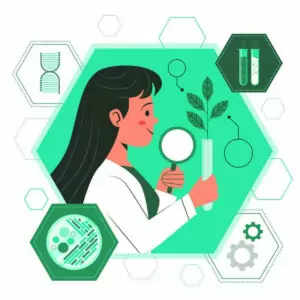In the realm of biology, transformation holds significant importance as one of the fundamental processes governing genetic material transfer among microbial cells. First explored in the 1920s by physician F. Griffith, transformation was observed in Streptococcus pneumoniae, where harmless cells could be converted into disease-causing ones. Over the years, our understanding of transformation has expanded with the discovery of DNA. This article delves into the intricacies of transformation, its role in molecular genetics, and its applications in the field of biology.

✅ AI Essay Writer ✅ AI Detector ✅ Plagchecker ✅ Paraphraser
✅ Summarizer ✅ Citation Generator
Understanding Transformation in Biology
Transformation, in the context of biology, refers to the process wherein a cell directly takes up exogenous genetic material and incorporates it through its cell membrane. This uptake is generally possible when the cell is in a state of competence, characterized by its ability to absorb foreign material. Competence is often a transient state, influenced by environmental conditions surrounding the cell.
The Three Processes of Genetic Material Transfer
In the realm of microbial cells, three processes facilitate genetic material transfer: transformation, conjugation, and archaeal DNA transfer. Among these, transformation involves the direct uptake of exogenous genetic material by a competent cell. Conjugation, on the other hand, entails the transfer of genetic material through direct cell-to-cell contact, facilitated by conjugative plasmids. Lastly, archaeal DNA transfer is a process observed in archaea, which share similarities with both bacteria and eukaryotes in terms of genetic material transfer.
Transformation in the Laboratory
Laboratories often harness the power of bacterial transformation in various molecular biology experiments. This four-step process starts with the preparation of competent cells that will undergo transformation. To achieve this, a desired bacterial strain is initially cultivated in a liquid medium, generating a starter culture. This culture is then expanded to ensure a sufficient quantity of competent cells. The cells are made competent through techniques like heat shock or electroporation.
Once the cells are in a state of competence, they are exposed to plasmid DNA and undergo another round of heat shock or electroporation. This enables the uptake of the plasmid DNA by the competent cells, effectively transforming them. Subsequently, these transformed cells are cultured again to enhance their viability and facilitate further molecular cloning processes.
Applications of Transformation in the Lab
The significance of transformation in molecular cloning cannot be understated. This process serves as a critical tool for various applications in the laboratory setting. Some of the key applications include:
- Genome Organization: Transformation aids in the organization of genomes, allowing scientists to study specific genetic elements and their functions.
- Recombinant Protein Production: By introducing foreign DNA into cells, researchers can produce valuable recombinant proteins for various applications, including medical and industrial purposes.
- Creation of Transgenic Organisms: Transformation enables the introduction of specific genes into an organism’s genome, leading to the creation of transgenic organisms with desirable traits.
- Gene Therapy: In the context of gene therapy, transformation can be used to deliver therapeutic genes into target cells to treat genetic disorders effectively.
- Protein Expression: Scientists can utilize transformed cells to express and produce specific proteins for further study or commercial use.
Transformation and Molecular Cloning
In the field of molecular cloning, the combination of colony microbiology and transformation plays a pivotal role. Molecular cloning involves the replication of a specific DNA sequence, resulting in multiple identical copies of the genetic material. This process is essential for studying gene functions and understanding cellular processes.
The Role of Competence in Transformation
Competence is a crucial aspect of transformation. It determines the cell’s ability to uptake exogenous genetic material. Cells typically achieve competence under specific environmental conditions, and the duration of this state is often limited. In natural competence, cells can uptake genetic material from their surroundings without any external intervention. Alternatively, researchers can induce competence artificially by treating laboratory cultures, making cell membranes permeable to exogenous genetic material.
Conclusion
Transformation in biology remains a vital process in the transfer of genetic material among microbial cells. From its initial discovery in the 1920s to the current advancements in molecular genetics, transformation continues to contribute significantly to scientific research and various applications in the laboratory. Understanding the intricacies of transformation opens up new possibilities for genetic manipulation and lays the groundwork for groundbreaking discoveries in the field of biology.
FAQ
How does transformation occur in a cell?
Transformation in a cell is a process wherein the cell directly takes up exogenous genetic material, such as DNA, from its surroundings and incorporates it into its own genome. This uptake of foreign genetic material occurs through the cell membrane. For transformation to take place, the cell must be in a state of competence, which is a temporary condition during which the cell can uptake exogenous DNA. Once the cell becomes competent, it becomes capable of incorporating the foreign DNA, leading to a transformed cell with new genetic information.
What is the difference between natural competence and artificial induction?
Natural competence and artificial induction are two different ways to achieve competence in a cell for the purpose of transformation.
Natural Competence: In natural competence, certain bacterial cells possess the inherent ability to uptake exogenous DNA from their environment without any external intervention. These cells have specialized machinery that facilitates the uptake of foreign genetic material, making them naturally competent for transformation.
Artificial Induction: Artificial induction, on the other hand, involves the deliberate and controlled creation of competence in bacterial cells through external means. Researchers can induce competence artificially by subjecting the cells to specific laboratory conditions, such as temperature changes (heat shock) or electrical pulses (electroporation). These treatments temporarily alter the cell membrane, making it permeable to exogenous DNA, and hence enabling transformation.
What is the four-step process of bacterial transformation in the lab?
The four-step process of bacterial transformation in the laboratory involves the following stages:
- Preparation of Competent Cells: The process begins with preparing competent cells, which are bacterial cells that have been made receptive to taking up exogenous DNA. This step typically involves cultivating a desired bacterial strain in a liquid medium to create a starter culture, followed by the expansion of this culture to yield a sufficient quantity of competent cells.
- Induction of Competence: The competent cells are induced to uptake foreign DNA by subjecting them to artificial methods like heat shock or electroporation. Heat shock involves exposing the cells to a sudden increase in temperature, while electroporation involves applying brief electrical pulses to the cells. Both methods temporarily disrupt the cell membrane, allowing the uptake of exogenous DNA.
- Incorporation of Plasmid DNA: Once the cells are in a state of competence, they are exposed to plasmid DNA, which carries the desired genetic material. The competent cells uptake the plasmid DNA, incorporating it into their own genome, effectively transforming them.
- Culturing Transformed Cells: The transformed cells are cultured again to enhance their viability and efficiency in the molecular cloning process. This step allows for the amplification of the transformed cells and ensures their stability for further experiments and applications.
How are transformed cells used in protein expression and plasmid isolation?
Transformed cells play vital roles in both protein expression and plasmid isolation:
Protein Expression: After transformation, the transformed cells contain the introduced DNA, which includes the gene of interest for protein expression. Scientists can then induce the transformed cells to express the specific protein of interest. The transformed cells act as protein factories, producing large quantities of the desired protein, which can be harvested and purified for further studies or commercial purposes.
Plasmid Isolation: Following transformation, the plasmid DNA carrying the gene of interest is now present within the transformed cells. To isolate the plasmid DNA, researchers use various techniques to extract and purify the DNA from the cellular components. Plasmid isolation is a critical step in obtaining the target DNA for cloning, sequencing, or other genetic manipulations.
Follow us on Reddit for more insights and updates.





Comments (0)
Welcome to A*Help comments!
We’re all about debate and discussion at A*Help.
We value the diverse opinions of users, so you may find points of view that you don’t agree with. And that’s cool. However, there are certain things we’re not OK with: attempts to manipulate our data in any way, for example, or the posting of discriminative, offensive, hateful, or disparaging material.